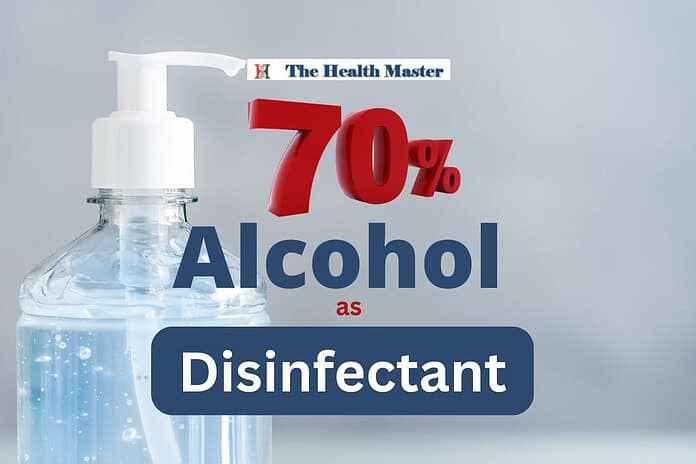- Key Notes on Revised Schedule M: API Part-3 - April 7, 2025
- Key Notes on Revised Schedule M: API Part-2 - March 28, 2025
- Key Notes on Revised Schedule M: API Part-1 - March 15, 2025
Last Updated on March 18, 2025 by The Health Master
Alcohol
Disinfectants play a crucial role in eliminating disease-causing microorganisms from surfaces and objects. Alcohol, particularly 70% isopropyl alcohol, is a popular choice for disinfection.
This article explores the reasons behind the widespread use of 70% alcohol as a disinfectant and its effectiveness in combating microorganisms.
Understanding Disinfectants and Their Function
Before delving into the specifics of alcohol as a disinfectant, it is important to grasp the purpose and mechanism of action of disinfectants.
These chemical agents are employed to kill or neutralize microorganisms such as bacteria and viruses, thereby preventing the spread of diseases. Disinfectants work by disrupting the cell wall of microorganisms, leading to their demise.
The Popularity of Alcohol as a Disinfectant
Alcohol has gained popularity as a disinfectant due to its effectiveness against a broad range of microorganisms. However, not all concentrations of alcohol yield the same results.
In fact, the use of 100% alcohol as a disinfectant is less effective than opting for a 70% alcohol solution.
The Importance of Concentration in Alcohol-Based Disinfectants
The Drawbacks of 100% Alcohol
- Contrary to popular belief, 100% alcohol is not the most efficient choice for disinfection.
- One of the primary reasons is its rapid evaporation rate, rendering it less effective against microorganisms.
- Its quick evaporation limits the contact time necessary to kill the pathogens effectively.
The Benefits of 70% Alcohol
- On the other hand, 70% alcohol, also known as rubbing alcohol, offers several advantages.
- By diluting alcohol with water, the evaporation rate slows down, allowing the alcohol to remain in contact with the microorganisms for an extended period.
- This prolonged exposure enhances its efficacy in eliminating harmful pathogens.
Enhancing Effectiveness through Slower Evaporation
The addition of water to alcohol plays a critical role in maximizing its effectiveness. Slower evaporation enables the alcohol to have more contact time with microorganisms, increasing the likelihood of their destruction. This characteristic distinguishes 70% alcohol from its 100% counterpart.
Penetrating the Microorganisms’ Cell Wall: The Role of Water
In addition to slower evaporation, the presence of water in 70% alcohol aids in penetrating the cell wall of microorganisms.
The water content assists in breaking down proteins and lipids within the cell wall, facilitating the entry of alcohol into the cell and ultimately causing its demise.
Safety Considerations: Flammability Comparison
Apart from its effectiveness, the safety of disinfectants is a paramount concern. In this regard, 70% alcohol offers an advantage over 100% alcohol.
The dilution reduces its flammability, making it a safer option for use in various settings where ignition risks need to be minimized.
Limitations of 70% Alcohol as a Disinfectant
While 70% alcohol is effective against a wide range of microorganisms, it is important to acknowledge its limitations.
Certain pathogens, such as the spores produced by Clostridium difficile, may not be effectively eliminated by alcohol-based disinfectants alone.
Effects of Alcohol on Bacterial Cells
(Input by Dr. D Roy Former DDC(I), CDSCO)
70% alcohol not being isotonic with bacterial cell fluid, creates an imbalance within the bacterial cells and draws water out of the cells, dehydrating them and thereby damage their structure and function.
Furthermore, the absolute alcohol with the absence of water can cause the bacterial cells to undergo a process called protein coagulation, which form a protection layer on the surface of the cell making it harder for alcohol to penetrate and kill the bacteria.
Conclusion: The Advantages of 70% Alcohol for Effective Disinfection
In conclusion, 70% alcohol is a preferred disinfectant due to its broad efficacy against microorganisms and reduced flammability compared to 100% alcohol.
The addition of water slows down evaporation, prolonging contact time with pathogens, while also aiding in penetrating their cell walls.
However, it is important to note that while 70% alcohol is effective against many types of microorganisms, certain exceptions exist, emphasizing.
Licensing procedure for manufacturing of Drugs
Procedure to obtain license for manufacturing of Cosmetics
Procedure to obtain license for manufacturing of Homoeopathic Medicines
Procedure to obtain license for manufacturing of Medical Devices
Procedure to obtain License to Manufacture drugs for testing and analysis purposes
Procedure to obtain license for Blood Centre (Blood Bank)
Procedure to obtain license for Commercial Testing Laboratories
Drug recall: Pediatric Drops recalled due to this reason
Govt strict on failure of samples of medicines
USFDA issues Form 483 with 4 observations to Aurobindo Pharma
NPPA fixed Ceiling price of 5 scheduled formulations: May 2023
NPPA revised Ceiling price of 15 scheduled formulations: May 2023
Pharma Industry seek price ceiling exemption for low cost drugs
One more arrest in Spurious Pharma Raw Material case
NPPA fixed retail price of 15 formulations: May 2023
Revising DT limit for Soft Gelatin Capsules: Pharma Industry seek solutions
Drug alert: 36 out of 895 samples declared as NSQ in April 2023
For informative videos by The Health Master, click on the below YouTube icon:
For informative videos on Medical Store / Pharmacy, click on the below YouTube icon:
For informative videos on the news regarding Pharma / Medical Devices / Cosmetics / Homoeopathy etc., click on the below YouTube icon:
For informative videos on consumer awareness, click on the below YouTube icon:









